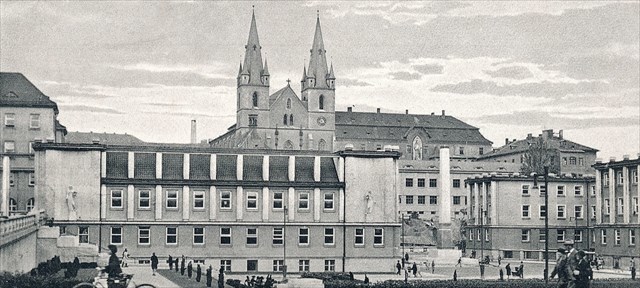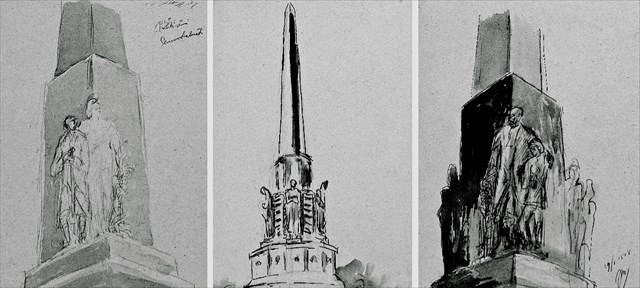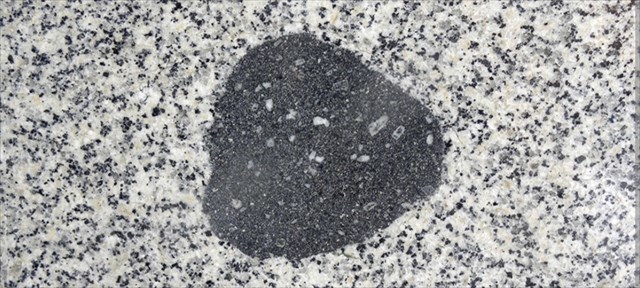|

 Žulový monolit pod Emauzským klášterem není zajímavý jen z historického hlediska. Vítejte u mé další EarthCache. Žulový monolit pod Emauzským klášterem není zajímavý jen z historického hlediska. Vítejte u mé další EarthCache.
 The granite monolith under the Emauzy Monastery is not only interesting from a historical point of view. Welcome to my next EarthCache. The granite monolith under the Emauzy Monastery is not only interesting from a historical point of view. Welcome to my next EarthCache.

Pomník legionářů / The Legionnares Monument
 Po asanaci původní zástavby historického Podskalí bylo mezi Vltavou a emauzským klášterem zřízeno podle projektu Bohumila Hypšmana nové náměstí, obklopené jednotně koncipovanými budovami státních úřadů. V hlavní pohledové ose, dané polohou západního průčelí klášterního kostela, byl 28. října 1932 odhalen monumentální památník československých legionářů, pojmenovaný "Praha svým vítězným synům". Autorem sochařské výzdoby pomníku byl Josef Mařatka (21. 5. 1874 – 20. 4. 1937), žák Augusta Rodina a jeden z oficiálních sochařů I. československé republiky. Spodní část 16 m vysokého žulového obelisku obepínají postavy sedmi legionářů (jednoho italského, dvou ruských a čtyř francouzských) a ženská figura, symbolizující město Prahu, která věnčí prapor lipovou ratolestí. Pozoruhodné je zejména detailní znázornění výzbroje a výstrojních součástek jednotlivých vojáků. Po asanaci původní zástavby historického Podskalí bylo mezi Vltavou a emauzským klášterem zřízeno podle projektu Bohumila Hypšmana nové náměstí, obklopené jednotně koncipovanými budovami státních úřadů. V hlavní pohledové ose, dané polohou západního průčelí klášterního kostela, byl 28. října 1932 odhalen monumentální památník československých legionářů, pojmenovaný "Praha svým vítězným synům". Autorem sochařské výzdoby pomníku byl Josef Mařatka (21. 5. 1874 – 20. 4. 1937), žák Augusta Rodina a jeden z oficiálních sochařů I. československé republiky. Spodní část 16 m vysokého žulového obelisku obepínají postavy sedmi legionářů (jednoho italského, dvou ruských a čtyř francouzských) a ženská figura, symbolizující město Prahu, která věnčí prapor lipovou ratolestí. Pozoruhodné je zejména detailní znázornění výzbroje a výstrojních součástek jednotlivých vojáků.
Pomník byl zničen po německé okupaci zbytku Československa, podařilo se zachránit jen schránku se zakládací listinou, kterou garážmistr Oldřich Rieger ukryl v Rakovníce. Snahy o jeho obnovu začaly nabývat na intenzitě po roce 1989. Podle původní dokumentace vytvořila bronzové sochy sochařka Kateřina Amortová, pomník byl znovu odhalen v den 80. výročí vzniku Československa 28. října 1998.
 After the clean-up of the original development of the historic Podskalí, a new square was established between the Vltava River and the Emauzy Monastery according to the project of Bohumil Hypšman, surrounded by uniformly designed state office buildings. On October 28, 1932, a monumental monument to Czechoslovak legionnaires named "Prague to its victorious sons" was unveiled in the main line of sight, given the position of the western facade of the monastery church. The author of the sculptural decoration of the monument was Josef Mařatka (21 May 1874 – 20 April 1937), a pupil of August Rodin and one of the official sculptors of the First Czechoslovak Republic. The lower part of the 16 m high granite obelisk is surrounded by the figures of seven legionnaires (one Italian, two Russian and four French) and a female figure, symbolizing the city of Prague, who crowns the banner with a linden branch. Particularly noteworthy is the detailed representation of the equipment and equipment components of individual soldiers. After the clean-up of the original development of the historic Podskalí, a new square was established between the Vltava River and the Emauzy Monastery according to the project of Bohumil Hypšman, surrounded by uniformly designed state office buildings. On October 28, 1932, a monumental monument to Czechoslovak legionnaires named "Prague to its victorious sons" was unveiled in the main line of sight, given the position of the western facade of the monastery church. The author of the sculptural decoration of the monument was Josef Mařatka (21 May 1874 – 20 April 1937), a pupil of August Rodin and one of the official sculptors of the First Czechoslovak Republic. The lower part of the 16 m high granite obelisk is surrounded by the figures of seven legionnaires (one Italian, two Russian and four French) and a female figure, symbolizing the city of Prague, who crowns the banner with a linden branch. Particularly noteworthy is the detailed representation of the equipment and equipment components of individual soldiers.
The monument was destroyed after the German occupation of the rest of Czechoslovakia, only the box with the charter was saved, which garage master Oldřich Rieger hid in Rakovníka. Efforts to restore it began to gain intensity after 1989. According to the original documentation, the bronze statues were created by the sculptor Kateřina Amortová, the monument was unveiled again on the 80th anniversary of the founding of Czechoslovakia on October 28, 1998.

Vyvřelá žula / Igneous granite
 Žula neboli granit je přírodní kámen, hlubinná vyvřelá hornina. Z velké části tvoří pevné části zemské kůry. Je mnohem tvrdší než mramor, její tvrdost je mezi 6 a 7 stupni v Mohsově stupnici tvrdosti, má vysokou hustotu a odolnost. Žula se skládá z několika minerálních látek, mezi hlavní z nich patří křemen (35%) a živec (40%). Právě živec v žule rozhoduje o její barvě. Žulový kámen bývá nejčastěji šedý s modrým odstínem, ale může mít i růžovou, žlutou nebo červenou barvu. Hlavním rysem žuly je zrnitost. Žula může být hrubozrnná, středně zrnitá nebo jemnozrnná. Malé a středně velké kameny granitu mají nižší pórovitost, a proto jsou více odolné. Žula neboli granit je přírodní kámen, hlubinná vyvřelá hornina. Z velké části tvoří pevné části zemské kůry. Je mnohem tvrdší než mramor, její tvrdost je mezi 6 a 7 stupni v Mohsově stupnici tvrdosti, má vysokou hustotu a odolnost. Žula se skládá z několika minerálních látek, mezi hlavní z nich patří křemen (35%) a živec (40%). Právě živec v žule rozhoduje o její barvě. Žulový kámen bývá nejčastěji šedý s modrým odstínem, ale může mít i růžovou, žlutou nebo červenou barvu. Hlavním rysem žuly je zrnitost. Žula může být hrubozrnná, středně zrnitá nebo jemnozrnná. Malé a středně velké kameny granitu mají nižší pórovitost, a proto jsou více odolné.
Vyvřelé horniny vznikají krystalizací, z malé části též sklovitým tuhnutím magmatu. Při postupném ochlazování magmatické taveniny krystalizují jednotlivé horninotvorné minerály a vytvářejí se magmatické horniny. Charakter horniny, která z magmatu vznikne, je závislý nejen na složení samotného magmatu, ale často též na fyzikálních podmínkách prostředí, ve kterém tuhnutí magmatu probíhá. V hlubších částech zemské kůry tuhne magma pomalu. Za takových podmínek vznikají horniny s jednotlivými, obvykle již makroskopicky rozlišitelnými minerály. Jestliže se však magma rozlévá na zemský povrch nebo na mořské dno, dochází k jeho velmi rychlému ochlazování. Proto není také dostatečný časový prostor k tomu, aby se mohly vytvořit makroskopicky pozorovatelné minerály, a vznikají tak nerosty zpravidla jen mikroskopických rozměrů nebo magma tuhne sklovitě. Proniká-li magma do trhlin a puklin v zemské kůře, tuhne v nich v podobě tzv. žil.
 Granite is a natural stone, deep igneous rock. They largely form the solid parts of the earth's crust. It is much harder than marble, its hardness is between 6 and 7 on the Mohs hardness scale, it has high density and resistance. Granite consists of several minerals, the main ones being quartz (35%) and feldspar (40%). It is the feldspar in granite that determines its color. Granite stone is most often gray with a blue tint, but it can also be pink, yellow or red. The main feature of granite is its grain size. Granite can be coarse-grained, medium-grained or fine-grained. Small and medium-sized granite stones have lower porosity and are therefore more durable. Granite is a natural stone, deep igneous rock. They largely form the solid parts of the earth's crust. It is much harder than marble, its hardness is between 6 and 7 on the Mohs hardness scale, it has high density and resistance. Granite consists of several minerals, the main ones being quartz (35%) and feldspar (40%). It is the feldspar in granite that determines its color. Granite stone is most often gray with a blue tint, but it can also be pink, yellow or red. The main feature of granite is its grain size. Granite can be coarse-grained, medium-grained or fine-grained. Small and medium-sized granite stones have lower porosity and are therefore more durable.
Igneous rocks are formed by crystallization, and to a small extent also by vitreous solidification of magma. As the magmatic melt gradually cools, individual rock-forming minerals crystallize and igneous rocks are formed. The character of the rock that is formed from the magma depends not only on the composition of the magma itself, but often also on the physical conditions of the environment in which the magma solidifies. In the deeper parts of the earth's crust, magma solidifies slowly. Under such conditions, rocks with individual, usually already macroscopically distinguishable, minerals are formed. However, if the magma spills onto the earth's surface or the seabed, it cools very quickly. Therefore, there is not enough time for macroscopically observable minerals to form, and minerals are usually only microscopic in size or the magma solidifies into glass. If magma penetrates cracks and fissures in the earth's crust, it solidifies in them in the form of so-called veins.

Xenolity / Xenolithes
 Xenolit znamená „cizí kámen“ pocházející z xenos (cizí) a lithos (kámen) ve starověké řečtině. Xenolit je fragment cizí horniny uvnitř hostitelské horniny. Xenolity se liší od horniny, ve které se nacházejí. Pokud jsou podobné povahy, pak se tyto horniny nazývají autolity nebo příbuzné inkluze. Skutečné xenolity jsou vždy starší než jejich hostitelské horniny, protože již musely existovat jako pevný úlomek horniny, když kolem nich ztuhlo magma nebo láva. Xenolit je často hornina, která byla při chladnutí zapuštěna do magmatu. Magma je roztavená hornina pod zemskou kůrou. Pokud magma vystoupí nad zemský povrch, například při sopečné erupci, označuje se jako láva. Láva je extruzní ekvivalent magmatu. Xenolit znamená „cizí kámen“ pocházející z xenos (cizí) a lithos (kámen) ve starověké řečtině. Xenolit je fragment cizí horniny uvnitř hostitelské horniny. Xenolity se liší od horniny, ve které se nacházejí. Pokud jsou podobné povahy, pak se tyto horniny nazývají autolity nebo příbuzné inkluze. Skutečné xenolity jsou vždy starší než jejich hostitelské horniny, protože již musely existovat jako pevný úlomek horniny, když kolem nich ztuhlo magma nebo láva. Xenolit je často hornina, která byla při chladnutí zapuštěna do magmatu. Magma je roztavená hornina pod zemskou kůrou. Pokud magma vystoupí nad zemský povrch, například při sopečné erupci, označuje se jako láva. Láva je extruzní ekvivalent magmatu.
Vyvřelé horniny se tvoří z magmatu a lávy, která se ochladí. Xenolity jsou různé typy hornin, které jsou často zapuštěny do vyvřelé horniny. V závislosti na cizím horninovém materiálu, složení magmatu nebo lávy, teplotách, dostupném čase a mnoha dalších faktorech se xenolit chemicky ekvilibruje s hostitelskou horninou v různé míře. Xenolity jsou obvykle snadno rozpoznatelné, protože se často viditelně liší složením, hustotou a barvou od obklopující horniny. Xenolity jsou obecně malé velikosti v poměru k celkovému tělesu horniny. Velikost xenolitů se však může pohybovat od monokrystalů až po několikametrové úlomky hornin.
 Xenolith means “foreign rock” coming from xenos (foreign) and lithos (stone) in Ancient Greek. A xenolith is a fragment of foreign rock within a host rock. Xenoliths are different from the rock they are found within. If they are similar in nature, then these rocks are called autoliths or cognate inclusions. True xenoliths are always older than their host rocks because they had to already exist as a solid rock fragment when the magma or lava around them solidified. This is not always the case with cognate inclusions. A xenolith is often a rock that was embedded in magma as it was cooling. Magma is the molten rock beneath the Earth’s crust. If the magma rises above the Earth’s surface, for example during a volcanic eruption, it is referred to as lava. Lava is the extrusive equivalent of magma. Xenolith means “foreign rock” coming from xenos (foreign) and lithos (stone) in Ancient Greek. A xenolith is a fragment of foreign rock within a host rock. Xenoliths are different from the rock they are found within. If they are similar in nature, then these rocks are called autoliths or cognate inclusions. True xenoliths are always older than their host rocks because they had to already exist as a solid rock fragment when the magma or lava around them solidified. This is not always the case with cognate inclusions. A xenolith is often a rock that was embedded in magma as it was cooling. Magma is the molten rock beneath the Earth’s crust. If the magma rises above the Earth’s surface, for example during a volcanic eruption, it is referred to as lava. Lava is the extrusive equivalent of magma.
Igneous rocks form from magma and lava that has cooled. Xenoliths are different types of rock that are often embedded in igneous rock. Depending on the foreign rock material, the composition of the magma or lava, the temperatures, available time, and many other factors, the xenolith chemically equilibrates with the host rock to varying degrees. Xenoliths are usually easy to recognise because they are often visibly different in composition, density and colour from the encompassing rock. Xenoliths are generally small in size, relative to the overall body of rock. However, xenoliths can range in size from single crystals (xenocrysts) to rock fragments of several metres.
 Pro zalogování jako "found it" mi musíte na email přes profil poslat odpovědi na následující otázky a úkoly: Pro zalogování jako "found it" mi musíte na email přes profil poslat odpovědi na následující otázky a úkoly:
1) Jak vznikají vyvřelé horniny a co jsou to xenolity?
2) Vyberte si jeden z xenolitů a popište, jak se liší jeho barva a textura od hostitelské horniny, žuly.
3) Nad nápisem „Terron Vouziers Champagne“ se nachází specifický xenolit. Jaký je jeho geometrický tvar?
4) Přidejte do logu fotku Vás, nebo vaší GPS s pomníkem legionářů.
 For log as "found it" please send me answers for those questions via my profile: For log as "found it" please send me answers for those questions via my profile:
1) How do igneous rocks form and what are xenoliths?
2) Choose one of the xenoliths and describe how it differs in color and texture from the host rock, granite.
3) Above the inscription "Terron Vouziers Champagne" there is a specific xenolith. What is its geometric shape?
4) Add a photo of you or your GPS with the memorial to the log.
 Logujte ihned po odeslání odpovědí, pokud bude něco špatně, ozvu se. Logujte ihned po odeslání odpovědí, pokud bude něco špatně, ozvu se.
 Log in as soon as the answers are sent, if there's anything wrong, I'll answer. Log in as soon as the answers are sent, if there's anything wrong, I'll answer.

|